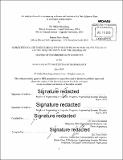| dc.contributor.advisor | Jarrod Goentzel. | en_US |
| dc.contributor.author | Blomberg, Per Niklas | en_US |
| dc.contributor.author | Gras Alomá, Ramon | en_US |
| dc.contributor.other | Massachusetts Institute of Technology. Engineering Systems Division. | en_US |
| dc.date.accessioned | 2015-11-09T19:49:57Z | |
| dc.date.available | 2015-11-09T19:49:57Z | |
| dc.date.issued | 2015 | en_US |
| dc.identifier.uri | http://hdl.handle.net/1721.1/99804 | |
| dc.description | Thesis: M. Eng. in Logistics, Massachusetts Institute of Technology, Engineering Systems Division, 2015. | en_US |
| dc.description | "June 2015." Cataloged from PDF version of thesis. | en_US |
| dc.description | Includes bibliographical references (pages 93-94). | en_US |
| dc.description.abstract | Airfreight forwarding companies must develop accurate forecasting tools to analyze the suitability and attractiveness of each incoming bidding process, to decide whether to participate in a tender and how to define the optimal commercial strategy. The "1:6" weight/volume ratio establishes that whenever the cargo ratio is different from 1:6 (1m3:167 kg) forwarders must pay the higher rate: either volume or weight. Given the main constraints in terms of volumetric capacity and maximum weight per volumetric unit, the most profitable business opportunities consist of combining in the same load compatible products with different densities. The main target is to come close as possible to the desired 1:6 ratio, to minimize the average price per load. To remain competitive, airfreight forwarding firms must improve their consolidation techniques, to combine in the same load cargo with compatible densities. The availability of robust analytical resources will allow airfreight industry companies to improve their rate of success, in terms of enhancing both efficiency (by increasing air volumes and densities) and profitability (by minimizing the Net Achieved Rate). This thesis develops an analytical model based on meaningful metrics to provide airfreight forwarders with an accurate and solid forecasting tool to select the bids under consideration that best match with their current portfolio in terms of air volume usage for a given origin-destination lane. It also predicts breakeven rates to increase profitability by minimizing the Net Achieved Rate. Furthermore, the model provides a series of metrics and visualization tools to help air freight forwarding companies to improve their understanding of their current portfolio for a given origin-destination lane and define their commercial strategy with respect to air freight cargo tenders. | en_US |
| dc.description.statementofresponsibility | by Per Niklas Blomberg and Ramon Gras Alomá. | en_US |
| dc.format.extent | 94 pages | en_US |
| dc.language.iso | eng | en_US |
| dc.publisher | Massachusetts Institute of Technology | en_US |
| dc.rights | M.I.T. theses are protected by copyright. They may be viewed from this source for any purpose, but reproduction or distribution in any format is prohibited without written permission. See provided URL for inquiries about permission. | en_US |
| dc.rights.uri | http://dspace.mit.edu/handle/1721.1/7582 | en_US |
| dc.subject | Engineering Systems Division. | en_US |
| dc.title | An analytical model to increase air volumes and minimize the Net Achieved Rate in air freight transportation | en_US |
| dc.type | Thesis | en_US |
| dc.description.degree | M. Eng. in Logistics | en_US |
| dc.contributor.department | Massachusetts Institute of Technology. Engineering Systems Division | |
| dc.identifier.oclc | 927167227 | en_US |
